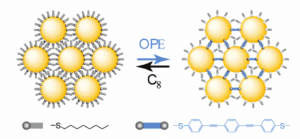
Monodispersed in size chemically synthesized gold nanoparticles covered with organic thiol-based shell (typically, C8H17SH, C12H25SH), being transferred on suspended water surface, form self-assembled monolayer (Nanoparticle Array), which can be then transferred on the Si substrate by soft lithography using PDMS stamps.

The size of the gap between neighboring nanoparticles is determined by the length of the thiol molecules used during process. These thiols can be replaced by different types of molecules. If the length of replaced molecules is suitable to bridge the gap, the network of molecular junctions (NanoParticle Self-Assembled Network, NPSAN) is formed.
References:
-
Liao, J., S. Blok, S. J. van der Molen, S. Diefenbach, A. Holleitner, C. Schönenberger, A. Vladyka, and M. Calame.
Chem. Soc. Rev. 44 (4) , 999-1014 (2015) .
![[DOI]](../../wp-content/plugins/papercite/img/external.png)
[Abstract]Arrays of metal nanoparticles in an organic matrix have attracted a lot of interest due to their diverse electronic and optoelectronic properties. Recent work demonstrates that nanoparticle arrays can be utilized as a template structure to incorporate single molecules. In this arrangement{,} the nanoparticles act as electronic contacts to the molecules. By varying parameters such as the nanoparticle material{,} the matrix material{,} the nanoparticle size{,} and the interparticle distance{,} the electronic behavior of the nanoparticle arrays can be substantially tuned and controlled. Furthermore{,} via the excitation of surface plasmon polaritons{,} the nanoparticles can be optically excited and electronically read-out. The versatility and possible applications of well-ordered nanoparticle arrays has been demonstrated by the realization of switching devices triggered optically or chemically and by the demonstration of chemical and mechanical sensing. Interestingly{,} hexagonal nanoparticle arrays may also become a useful platform to study the physics of collective plasmon resonances that can be described as Dirac-like bosonic excitations.
-
SYMONE Project: Synaptic Molecular Networks for Bio-Inspired Information ProcessingWendin, G., Dominique Vuillaume, M. Calame, S. Yitzchaik, Christian Gamrat, Gianaurelio Cuniberti, and V. Beiu.
-
Mangold, Markus A., Michel Calame, Marcel Mayor, and Alexander W. Holleitner.
ACS Nano 6 (5) , 4181-4189 (2012) .
![[DOI]](../../wp-content/plugins/papercite/img/external.png)
[Abstract]We investigate the photoconductance of gold nanoparticle arrays in the Coulomb blockade regime. Two-dimensional, hexagonal crystals of nanoparticles are produced by self-assembly. The nanoparticles are weakly coupled to their neighbors by a tunneling conductance. At low temperatures, the single electron charging energy of the nanoparticles dominates the conductance properties of the array. The Coulomb blockade of the nanoparticles can be lifted by optical excitation with a laser beam. The optical excitation leads to a localized heating of the arrays, which in turn gives rise to a local change in conductance and a redistribution of the overall electrical potential in the arrays. We introduce a dual-beam optical excitation technique to probe the distribution of the electrical potential in the nanoparticle array. A negative differential photoconductance is the direct consequence of the redistribution of the electrical potential upon lifting of the Coulomb blockade. On the basis of our model, we calculate the optically induced current from the dark current–voltage characteristics of the nanoparticle array. The calculations closely reproduce the experimental observations.
-
Mangold, Markus A., Michel Calame, Marcel Mayor, and Alexander W. Holleitner.
-
Liao, J., J. S. Agustsson, S. Wu, O. Jeannin, Y. -F. Ran, S. -X. Liu, S. and Decurtins, Y. Leroux, and M. Mayor<em>, et al</em>.
-
Calame, Michel.
-
Mangold, M. A., C. Weiss, M. Calame, and A. W. Holleitner.
Appl. Phys. Lett. 94 , 161104 (2009) .
![[DOI]](../../wp-content/plugins/papercite/img/external.png)
[Abstract]We report on a photoconductive gain effect in two-dimensional arrays of gold nanoparticles (NPs) in which alkane molecules are inserted. The NP arrays are formed by a self-assembly process from alkanethiol-coated gold NPs, and subsequently they are patterned on a Si/SiO2 chip by a microcontact printing technique. We find that the photoconductance of the arrays is strongly enhanced at the frequency of the surface plasmon of the NPs. We interpret the observation as a bolometric enhancement in the conductance of the NP arrays upon excitation of the surface plasmon resonance
-
van der Molen, S. J., J. Liao, T. Kudernac, J. S. Agustsson, L. Bernard, M. Calame, B. J. van Wees, B. Ferringa, and C. Schönenberger.
-
Liao, Jianhui, Markus Mangold, Sergio Grunder, Marcel Mayor, Christian Schönenberger, and Michel Calame.
-
Bernard, L., Y. Kamdzhilov, M. Calame, S. J. van der Molen, J. Liao, and C. Schönenberger.
-
Bernard, L., M. Calame, S. J. van der Molen, J. Liao, and C. Schönenberger.
-
Liao, Jianhui, Laetitia Bernard, Michael Langer, Christian Schönenberger, and Michel Calame.